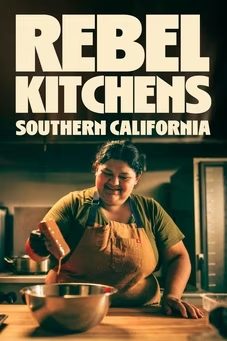
Kathi Langelier’s Fire Cider
Season 7 Episode 1 | 5m 30sVideo has Closed Captions
See why people love to keep fire cider in stock during the cold Winter months.
Fire cider has all the fiery flavors, including hot peppers, horseradish, garlic, and ginger, to name a few. Add the sweetness of honey and the tangy bite of apple cider vinegar and you will be sold! It is perfect when it’s really cold outside and you need your insides warmed and your body energized.
Problems playing video? | Closed Captioning Feedback
Problems playing video? | Closed Captioning Feedback

Kathi Langelier’s Fire Cider
Season 7 Episode 1 | 5m 30sVideo has Closed Captions
Fire cider has all the fiery flavors, including hot peppers, horseradish, garlic, and ginger, to name a few. Add the sweetness of honey and the tangy bite of apple cider vinegar and you will be sold! It is perfect when it’s really cold outside and you need your insides warmed and your body energized.
Problems playing video? | Closed Captioning Feedback
How to Watch Kitchen Vignettes
Kitchen Vignettes is available to stream on pbs.org and the free PBS App, available on iPhone, Apple TV, Android TV, Android smartphones, Amazon Fire TV, Amazon Fire Tablet, Roku, Samsung Smart TV, and Vizio.

Get More Kitchen Vignettes
Get more recipes on the Kitchen Vignettes blog. Available on PBS Food.Providing Support for PBS.org
Learn Moreabout PBS online sponsorship(knife scraping) (bright music) - Today we're making fire cider.
And the reason I chose fire cider is because it's such an accessible recipe to make.
It's something that everybody can easily make.
Fire cider is a fabulous home remedy and it's a wonderful upper respiratory decongestant.
It's wonderful for circulation and energizing the body.
And it's very versatile.
You don't have to just take a shot of it.
I make my soups with it.
I roast my vegetables with it.
I make my salad dressings with it.
It's great in Bloody Marys 'cause it's a very savory hot food.
And I use it as a food.
My name is Kathi Langelier and my farm is located in Union, Maine.
Here on the farm we grow a blend of vegetables and medicinal herbs and culinary herbs.
I've been studying and making plant medicine for over 25 years.
But as a business, I have been running Herbal Revolution for 11 years.
When I learned how to make fire cider, I was apprenticing on this farm where I was also learning for the first time how to make pickles, how to grind my own flour, how to make cheese and my own other herbal remedies and syrup.
You name it, you know, putting food up.
And this was one of the things that I was learning to put up from that year's harvest.
Growing my own ingredients, it's like a feeling.
It makes my heart burst open.
I feel like I'm the wealthiest person alive.
It feels like magic going out into the fields every day and seeing these plants that started from seed.
I feel like this deep gratitude that there's no words to explain.
To be able to just go into my backyard and harvest to me is the richest thing in the world.
(gentle piano music) So first I gather all my ingredients and then I usually start with the things that needs to be grated first.
So I'll grate the horseradish, the purpose for the horseradish is that it's an incredible decongestant.
If you've ever had with wasabi, wasabi is horseradish and it can just clear your nasal passage right out.
So this is a very important ingredient.
Ginger and turmeric, I like to use because they're incredible anti-inflammatories.
They are supportive to the digestive system.
The onions are anti-inflammatory and they're also a decongestant.
Garlic is antibacterial, antimicrobial, and it's also an anti-inflammatory.
Hot peppers are warming, they're spicing, they're energizing, they get our circulatory system going.
And then you can alter, you can add some things, you know, that you have growing.
So for instance, I love bringing in the savory flavors of rosemary and thyme.
These are antiviral herbs, they're antibacterial herbs.
I like to use hyssop, this is another fabulous herb that's an expectorant.
It can help break things up in the chest and get them out.
Other things that I have growing that I love, nasturtiums bring a really nice spice to it.
The flowers I tend to leave whole because I like to see them in the jar.
I'll then layer that into the jar and I will add the honey.
And then the vinegar.
I'll usually have a skewer of some sort to help get air bubbles out.
And then I will shake that daily and add more vinegar as needed.
And then after about four to six weeks, I will strain and I'll save the ingredients and use that as a chutney.
I think that it's really important to bring that connection back that food is medicine.
Plants, they're meant to feed and nourish our bodies, but they can also help mend our bodies or help support our bodies in staying vital.
And fire cider, it was always put out there to be shared with others.
In 2014, the herbal community learned that the term fire cider had been trademarked by a company making it so that other herbalists like myself could no longer sell fire cider.
And while we were in the midst of petitioning against this trademark, the company turned around and sued myself and two other herbalists.
In the fall of 2019, we learned that we won our lawsuit and fire cider is now back in the hands of the herbalist, the farmers and the people to use it as they freely want to.
So fire cider is now considered a generic term, meaning that it can not be ever trademarked again.
Working with plants is such an accessible way for people to empower themselves, to take back their health.
And there's a lot of work that we can do preventatively and working with plants and plant medicines is one of the best preventative care things that we can be doing.
(inspiring music)
Support for PBS provided by:















